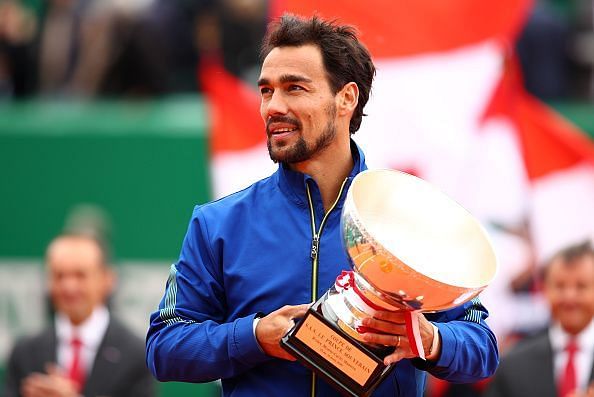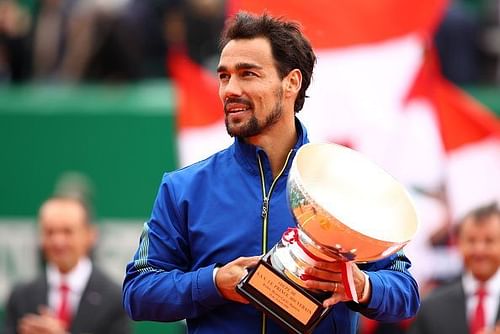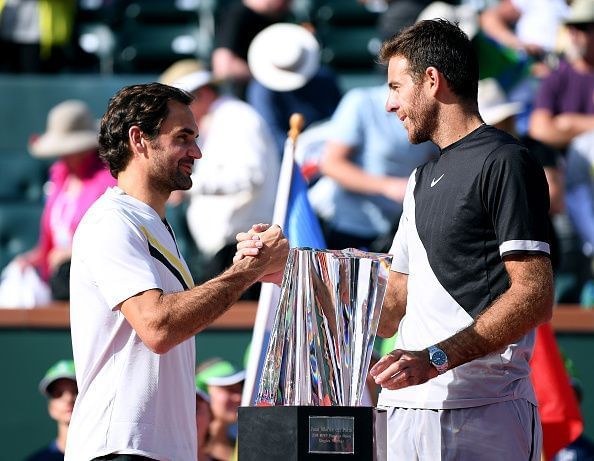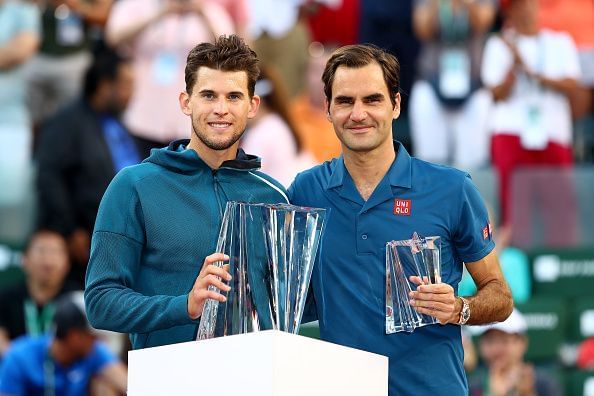
Which player will join the Masters 1000 winners' circle after Fabio Fognini?
Italy’s Fabio Fognini finally came of age last week as he beat Dusan Lajovic to win the Monte Carlo Masters. With that, the 31-year-old became the second oldest first-time winner of a Masters 1000. He also became the eighth new player to win a Masters 1000 in the past 2 years.
Fognini has always been something of an enigma. He has frequently beaten great players such as Andy Murray and Rafael Nadal, but then fallen at the next hurdle.
In Monte Carlo, he overcame this impasse and a number of injury issues to stun Nadal with some fine clay-court attacking tennis from the baseline, in the process denying the Spaniard an unprecedented 12th title in the Principality.

Before 2017, the Masters tournaments were dominated by the big four of Federer, Nadal, Djokovic and Murray. There was the odd win here and there for Stan Wawrinka who won in Monte Carlo in 2014, and Marin Cilic who triumphed in Cincinnati in 2016, but everyone knew where the power lay.
Neither Cilic or Wawrinka have been able to add to their sole Masters 1000 trophy.
However, the past two seasons have seen a challenge to the men’s monopoly and a new sea of change which has been nice for everyone to see.
Alexander Zverev, 22, is a fantastic example. He may be suffering an alarming dip in form right now, but in 2017 he made some fantastic breakthroughs. When only 20 years of age he won the Italian Open, his first Masters 1000 title, beating Djokovic in the final in straight sets.
If that wasn’t enough, he then won the very next Masters tournament in Montreal, the Canadian Masters, by upsetting an in-form Federer. Pundits speculated that the Swiss may have been carrying an injury in that final, but there was no denying Zverev's coming of age.
Last year in 2018 the German carried on his affinity with the Masters 1000 format, making the final in Miami and winning in Madrid by beating Dominic Thiem to add to his wide array of clay-court titles. He then backed this up getting to the final of the Italian Open before being outclassed by Nadal, thus ending his title defence.
Zverev should take heart from the early promise that his career has shown. He is now one of the very few players to have won multiple Masters 1000 titles outside of the big four.
Zverev was the first of three new Masters 1000 winners in the 2017 tennis season. Bulgaria’s Grigor Dimitrov, once touted as the next big thing, defeated Nick Krygios in the final of the Cincinnati Masters in August 2017 to win his maiden Masters 1000 title, the biggest title of his career at the time.
Dimitrov then won the Tour Finals in London in 2017 and got as high as world number three. But he disappointed in 2018 and has now fallen outside the world’s top 20 as he struggles for form and motivation.
At the Paris Masters, Jack Sock became the third new player to win a Masters 1000 in 2017 beating surprise finalist, Serbia’s Filip Krajinović. That catapulted him into the world’s top 10 and a place in the ATP Finals lineup.
Last season in 2018 we saw even more tidal waves in the Masters 1000 format.
At Indian Wells, 2009 US Open champion Juan Martin Del Potro saved two match points to beat the defending champion Federer in a tightly contested three-setter to win his first Masters 1000.

Del Potro went on to have a strong season, making the final of the US Open again and going as high as world number three.
However, a knee injury sustained after a nasty fall at the Shanghai Masters last October denied the Argentine the chance to participate in the London Tour finals. And in 2019 the knee injury prevented him from being able to defend his titles in Acapulco and at Indian Wells in the Californian desert.
Del Po is entered for the Madrid Open in May and has opted against knee injury, which appears to be a positive sign.
Last year’s Miami Masters saw John Isner beat Juan Martin Del Potro in the semi-finals, denying the Argentine the “Sunshine Double”, and beating Alexander Zverev in the final.
Isner became the first American to win the Miami Masters in over a decade. He is also the last player to win at the Crandon Park venue at Key Biscayne, Florida.
Another interesting aspect was that at 32 years old, Isner became the oldest first time Masters 1000 champion.
If two new winners weren’t enough in 2018, a third came along in the final Masters event of the season as young Next Gen star Karen Khachanov defeated Novak Djokovic in straight sets in Paris.
This denied the Serb from winning a third straight Masters 1000 and prevented him from securing a 33rd Masters trophy, which would have seen him equal Nadal’s record.
Now in 2019, the trend seems to be continuing as Thiem, having previously lost two Masters 1000 finals, both in Madrid and on clay, was able to excel at Indian Wells, denying Federer a record sixth title in the Californian desert.

Thiem then went out early in both Miami and Monte Carlo, losing to eventual finalist Dusan Lajovic in the latter. However, he has turned his form around on clay beating Nadal in the semi-finals of the Barcelona Open. He will also have a lot of points to defend in Madrid after making the finals there last year.
The Austrian also made the French Open final last year, so there is a distinct possibility that he may have what it takes to become a new Grand Slam champion.
With three new Masters 1000 winners in 2017, a further three in 2018 and two this year (and counting) after Fognini’s latest conquest, it will be interesting to see if anyone else can break new ground this year.
Japan’s Kei Nishikori has lost five times in Masters 1000 finals, the most of any player in Masters 1000 history not to win one. It's an unwanted statistic for a tennis player if there ever was one; he will be aiming to make it 6th time lucky this year.
Other fringe players around the top 10 and top 20 in the world such as Gael Monfils, Nick Krygios and Roberto Bautista Agut will also aim to join the esteemed company.
My personal tip is on one of the Next Gen to next win a Masters 1000. Denis Shapovalov, who has made three Masters 1000 semi-finals (in Toronto 2017, Madrid Open 2018 and the Miami Masters 2019), appears to be getting closer and closer to a maiden Masters final.
Stefanos Tsitsipas, who lost in last year’s Toronto Canadian Masters final to Nadal, and Borna Coric, who stunned Federer in the semi-finals before being beaten by Djokovic in the Shanghai Masters final, could also bridge the gap and win a Masters 1000.
Now the floodgates are well and truly open and more and more players have the confidence to compete with Federer, Nadal, Djokovic and Murray. It will be fascinating to see who the next new Masters winner will be.